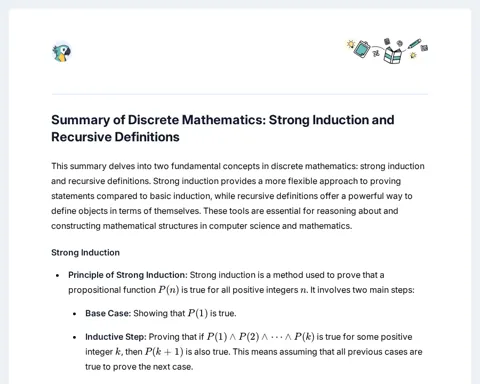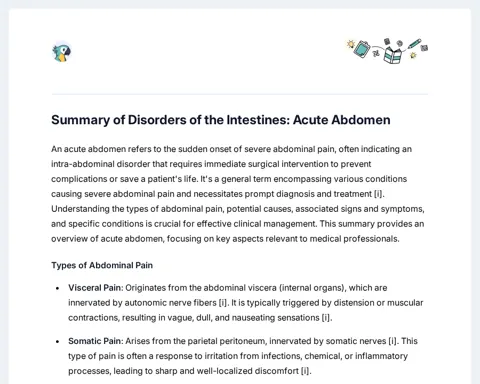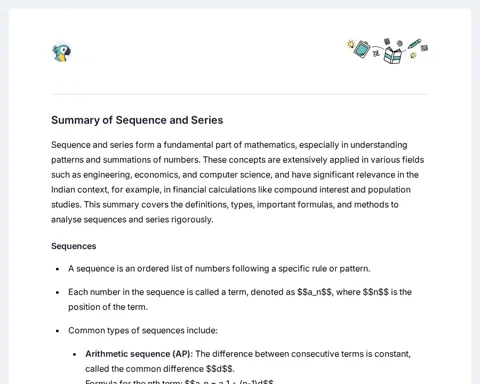Summary of Lines and Angles - Triangle
This summary aims to provide a clear understanding of the key concepts related to triangles, tailored for students in 9th grade. We'll explore the fundamental properties of triangles, focusing on angles, sides, and important theorems. Get ready to dive into the world of triangles!
Introduction to Triangles
- Definition: A triangle is a closed figure formed by three intersecting lines. It has three sides, three angles, and three vertices.
- Notation: A triangle with vertices A, B, and C is denoted as .
- Elements: The sides are AB, BC, and CA; the angles are , , and .
Angle Sum Property of a Triangle
- Theorem: The sum of all angles in a triangle is always 180 degrees.
- Proof: This can be proven using parallel lines and transversal properties. Draw a line parallel to one side of the triangle through the opposite vertex.
- Importance: This property is fundamental in solving many geometry problems involving triangles.
Types of Triangles
- Based on Sides:
- Equilateral Triangle: All three sides are equal, and each angle is 60 degrees.
- Isosceles Triangle: Two sides are equal, and the angles opposite these sides are also equal.
- Scalene Triangle: All three sides are of different lengths, and all angles are different.
- Based on Angles:
- Acute-angled Triangle: All angles are less than 90 degrees.
- Right-angled Triangle: One angle is exactly 90 degrees.
- Obtuse-angled Triangle: One angle is greater than 90 degrees.
Properties of Isosceles Triangles
- Theorem: Angles opposite to equal sides in an isosceles triangle are equal.
- Converse: Sides opposite to equal angles in a triangle are equal (this also makes the triangle isosceles).
- Application: These properties help in proving various geometric relationships and solving problems related to isosceles triangles.
Congruence of Triangles
- Definition: Two triangles are congruent if they have the same shape and size.
- Congruence Rules:
- SAS (Side-Angle-Side): If two sides and the included angle of one triangle are equal to the corresponding two sides and included angle of another triangle, the triangles are congruent.
- ASA (Angle-Side-Angle): If two angles and the included side of one triangle are equal to the corresponding two angles and included side of another triangle, the triangles are congruent.
- SSS (Side-Side-Side): If three sides of one triangle are equal to the corresponding three sides of another triangle, the triangles are congruent.
- RHS (Right-Hypotenuse-Side): If in two right triangles, the hypotenuse and one side of one triangle are equal to the hypotenuse and one side of the other triangle, the triangles are congruent.
- CPCT: Corresponding Parts of Congruent Triangles are equal.
Inequalities in a Triangle
- Angle-Side Relationship: In any triangle, the angle opposite the longer side is larger, and vice versa.
- Triangle Inequality: The sum of any two sides of a triangle is always greater than the third side.
- , ,
- Application: These inequalities help determine if a triangle can be formed with given side lengths and provide a basis for comparing angles and sides.
Some Important Terms
- Median: A line segment from a vertex to the midpoint of the opposite side.
- Altitude: A perpendicular line segment from a vertex to the opposite side (or its extension).
- Angle Bisector: A line that divides an angle into two equal angles.
- Perpendicular Bisector: A line that is perpendicular to a side and passes through its midpoint.
Conclusion
This summary has covered the essential concepts of triangles, including their properties, types, congruence rules, and inequalities. Remember to practice these concepts with various problems to strengthen your understanding. All the best for your studies! 




